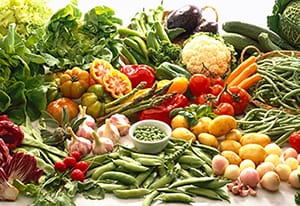Eating Heart-Healthy Food: Using the DASH Plan

Eating for your heart doesn’t have to be hard or boring. You just need to know how to make healthier choices. The DASH eating plan has been developed to help you do just that. DASH stands for Dietary Approaches to Stop Hypertension. It is a plan that has been proven to be healthier for your heart and to lower your risk for high blood pressure. It can also help lower your risk for cancer, heart disease, osteoporosis, and diabetes.
Choosing from each food group
Choose foods from each of the food groups below each day. Try to get the recommended number of servings for each food group. The serving numbers are based on a diet of 2,000 calories a day. Talk to your doctor if you’re unsure about your calorie needs. Along with getting the correct servings, the DASH plan also recommends a sodium intake less than 2,300 mg per day.
Try staying clear of these “Salty Six” foods:
- Breads & Rolls: bread can add up to be a lot of sodium, especially if it’s apart of your daily diet. Try to substitute lower sodium varieties.
- Cold Cuts & Cured Meats: one 2 oz. serving, or 6 thin slices of deli meat can contain as much as half of your daily recommended sodium intake. Read the labels, and choose a lower sodium deli meat as an option.
- Pizza: One slice of pizza with several toppings can contain more than your daily recommended sodium. Try something new and create your own pizza. Limit your amount of cheese, and add vegetables to your master piece.
- Poultry: sodium levels vary for poultry, depending on how it is prepared. Choose your chicken products wisely.
- Soup: sodium in one cup of canned soup can range from 100-940 milligrams of salt. Check your labels.
- Sandwiches and Burgers: a sandwich or burger from a fast food restaurant can contain more than 100 percent of your daily recommended sodium. Enjoy your food, but try doing half a sandwich or burger.
-Recommended by: The American Heart Association
GrainsServings: 6-8 a day A serving is:
Best choices: Whole grains and any grains high in fiber. |
VegetablesServings: 4-5 a day A serving is:
Best choices: Fresh or frozen vegetables prepared without added salt or fat. |
FruitsServings: 4-5 a day A serving is:
Best choices: A variety of fresh fruits of different colors. Whole fruits are a better choice than fruit juices. |
Low-fat or fat-free dairyServings: 2-3 a day A serving is:
Best choices: Skim or 1% milk, low-fat or fat-free yogurt or buttermilk, and low-fat cheeses. |
Lean meats, poultry, fishServings: 6 or fewer a day A serving is:
Best choices: Lean poultry and fish. Trim away visible fat. Broil, grill, roast, or boil instead of frying. Remove skin from poultry before eating. Limit how much red meat you eat. |
Nuts, seeds, beansServings: 4-5 a week A serving is:
Best choices: “Dry roasted” nuts with no salt added, lentils, kidney beans, garbanzo beans, and whole pinto beans. |
Fats and oilsServings: 2-3 a day A serving is:
Best choices: Nut and vegetable oils (non-tropical vegetable oils), such as olive and canola oil. |
SweetsServings: 5 a week or fewer A serving is:
Best choices: Dried fruit can be a satisfying sweet. Choose low-fat sweets. And watch your serving sizes! |
– See more at: http://krames.forthealthcare.com/Search/3,84424#sthash.A9HNOyqs.dpuf
